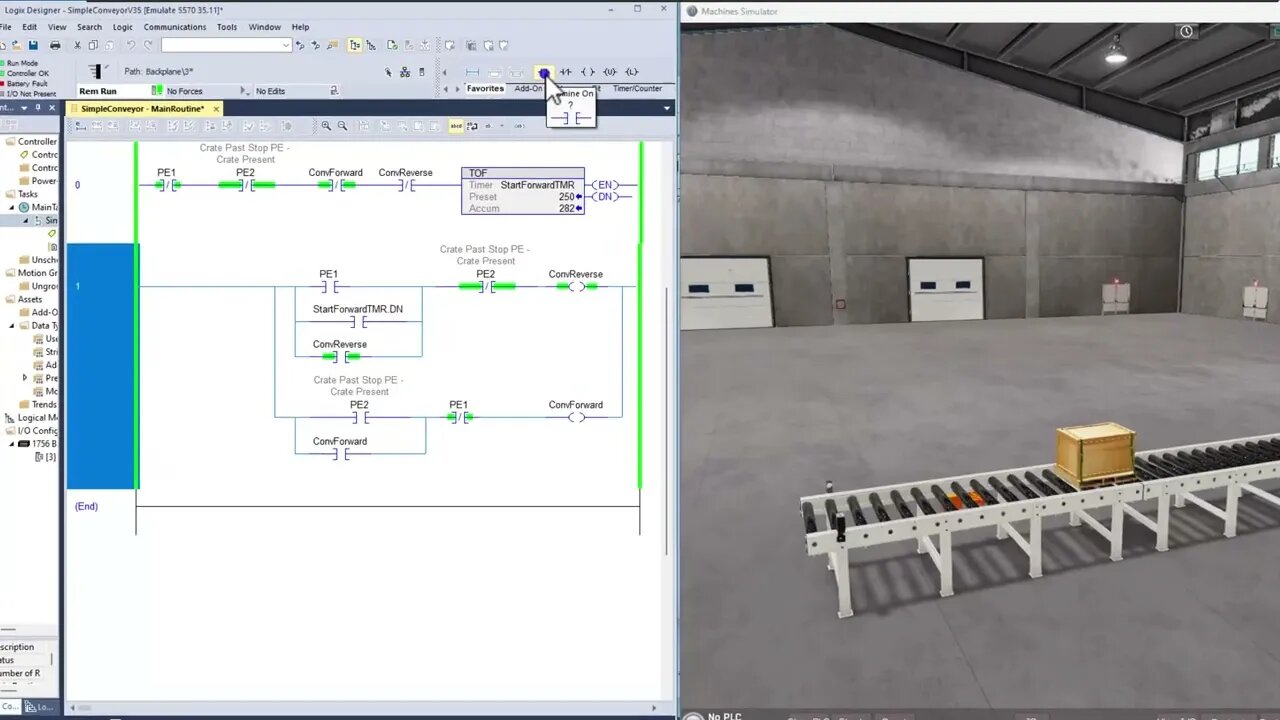Premium Only Content

PLC Ladder Logic Basics For Beginners With A Working Conveyor
Ladder logic is a programming language used in industrial automation systems, such as those found in manufacturing plants. It is a graphical representation of a program, with symbols and lines representing logical statements and actions. Allen-Bradley is a brand of programmable logic controllers (PLCs) that uses ladder logic to control industrial processes.
For beginners learning ladder logic, a good starting point is understanding how it is used to control a conveyor system. A conveyor system consists of a series of rollers or belts that move materials from one location to another. It is commonly used in manufacturing and material handling applications.
To control a conveyor system using ladder logic, we need to first understand the inputs and outputs of the system. Inputs are signals that are received by the PLC, such as button presses or sensor readings. Outputs are signals that are sent by the PLC, such as turning on a motor or activating a solenoid valve.
Next, we need to determine the logic of the system. For example, if we want the conveyor to start when a button is pressed and stop when a sensor detects an object, we would create a ladder logic program that reads the button press input and the sensor input. If the button is pressed and the sensor is not detecting an object, the program will send an output signal to start the conveyor. If the sensor detects an object, the program will send an output signal to stop the conveyor.
To create the ladder logic program, we use symbols and lines to represent the inputs, outputs, and logic of the system. A common symbol for an input is a square, and a common symbol for an output is a circle. Lines are used to connect the symbols and represent the logic of the program.
Here is an example of a simple ladder logic program for a conveyor system:
[Input] [Output]
[Button]--[Conveyor]
[Sensor]--[Stop]
In this program, the input symbol on the left represents the button press, and the output symbol on the right represents the conveyor motor. The line connecting the two represents the logic that if the button is pressed, the conveyor will start. The input symbol below the button represents the sensor, and the output symbol below the conveyor represents the stop signal. The line connecting the two represents the logic that if the sensor detects an object, the conveyor will stop.
Ladder logic can become more complex as the system becomes more sophisticated, but this basic example illustrates the concept of using inputs, outputs, and logic to control a conveyor system using Allen-Bradley PLCs and ladder logic. With practice and a thorough understanding of the principles of ladder logic, beginners can confidently control and automate industrial processes using this powerful programming language.
Thank you for watching the video.
Learn, Implement, Succeed
Visit:
https://www.allen-bradley-plc-training.com/
Other social media:
LinkedIn: https://www.linkedin.com/in/shane-welcher-sr/
Facebook: https://www.facebook.com/OnlinePLCSupport
#LadderLogicBasics #LadderLogicBeginners #ladderlogic
-
 7:41
7:41
Shane Welcher
1 year agoScaling a PIDE Output for a 4 to 20MA signal
28 -
 8:43
8:43
Film Threat
21 hours agoTHE MONKEY | Film Threat Reviews
21.5K1 -
 15:55
15:55
TSPLY
1 day agoThe Media Is Very Afraid Of FBI Director Kash Patel
14.7K14 -
 6:57
6:57
Cooking with Gruel
17 hours agoMake Cheese Great Again
13K7 -
 5:17
5:17
Mrgunsngear
20 hours ago $1.84 earnedPresident Trump Has Appointed A New ATF Director
21.7K22 -
 48:17
48:17
Athlete & Artist Show
8 days ago $0.01 earnedS5E1: Chucky Announces First Kid, 4 Nations Face Off, and more!
10.5K -
 38:30
38:30
hickok45
5 hours agoSunday Shoot-a-Round # 269
25.6K11 -
 1:39:55
1:39:55
Squaring The Circle, A Randall Carlson Podcast
1 day ago#040 Humanity's Expansion Into The Cosmos: A New Age - Squaring The Circle
15.7K3 -
 12:54
12:54
ariellescarcella
15 hours agoYou're NOT Queer, Just Annoying And Boring
10.2K8 -
 18:57
18:57
Fit'n Fire
11 hours ago $0.03 earnedA PDW That Thumps -- Stribog SP45A3 45ACP
14.6K1